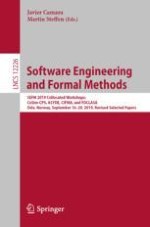The volume LNCS 12226 constitutes the revised selected papers from the four workshops collocated with the 17th International Conference on Software Engineering and Formal Methods, SEFM 2019.
The 13 full papers presented together with 7 short papers in this volume were carefully reviewed and selected from a total of 45 submissions. They stem from the following workshops:
CoSim-CPS 2019 – 3rd International Workshop on Formal Co-Simulation of Cyber-Physical Systems; ASYDE 2019 -- 1st International Workshop on Cognition: Interdisciplinary Foundations, Models and Applications; and FOCLASA 2019 -- 17th International Workshop on Foundations of Coordination Languages and Self-Adaptive Systems.
